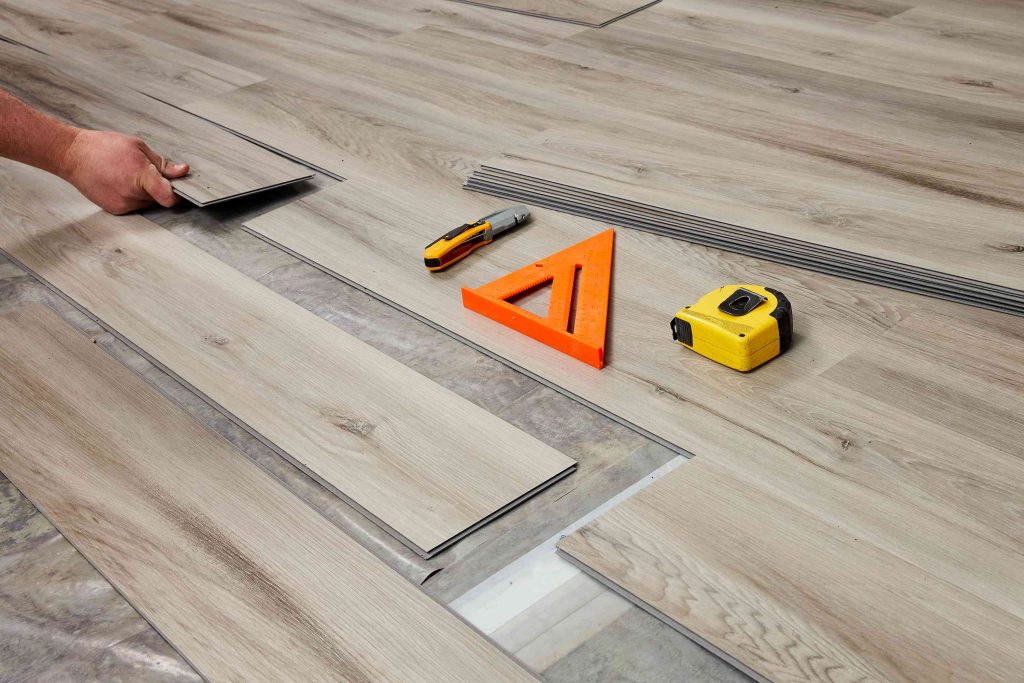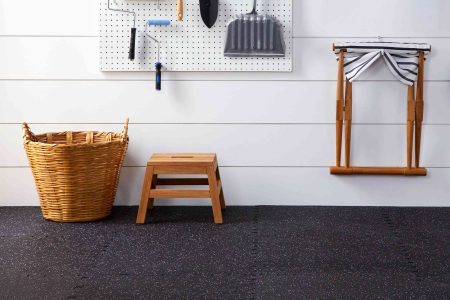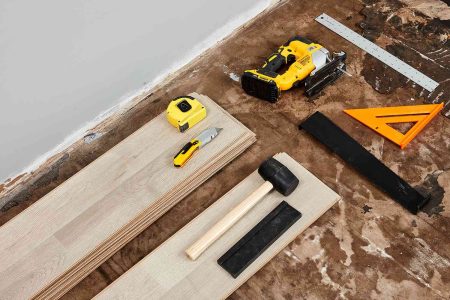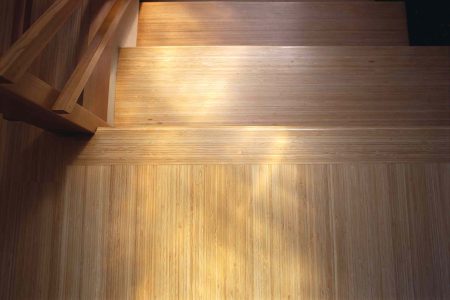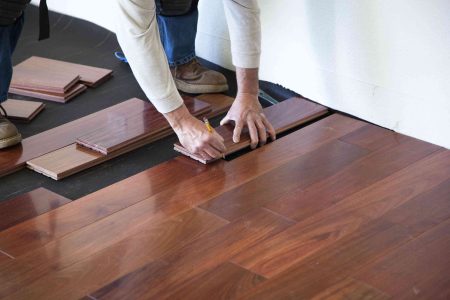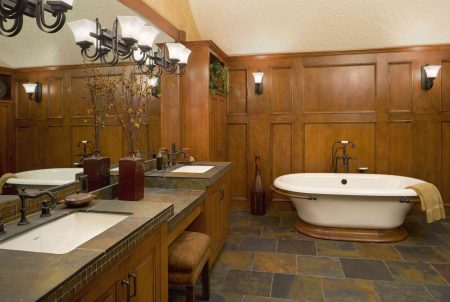Floating floors have become increasingly popular for many types of floor coverings. The term “floating floor” does not refer to a type of flooring material, but rather to a method of installation that can be used with a variety of materials, including laminates, engineered hardwood, and luxury vinyl flooring. In this method, individual planks (or in some cases tiles) interlock edge-to-edge to form a single mat-like surface that simply rests on the underlayment. It is quite different from the glue-down or nail-down methods that are still used for ceramic and stone tiles, and which were once standard for pretty much all flooring materials.
What Is a Floating Floor?
Floating floors are flooring installations in which the flooring material “floats” over the subfloor and underlayment.
Due to its ease and simplicity, floating floor installation saves money and helps installation go a lot faster, making it a favorite method for DIYers. But a good floating floor installation requires a perfectly prepared subfloor, and in some instances, it can have a hollow feeling underfoot that is less pleasing than the solidity of nailed-down hardwood or bonded ceramic tile.
-
Inexpensive
-
Easy to replace damaged planks
-
Easy DIY installation
-
May lower real estate value
-
Can feel hollow and loud underfoot
-
Cannot be refinished
Floating Floor Examples
There are three types of flooring that are most commonly installed with floating floor methods:
- Laminate flooring: The prime example of a floating floor is laminate flooring, which is almost never glued down to the subfloor. The floating method allows the flooring to respond to changes in a room’s relative humidity by expanding and contracting without buckling. Laminate flooring planks are generally joined together along the edges and end with a modified tongue-and-groove system, often known as “click-lock” or “fold-and-lock.” The shape of the interlocking grooves may vary from manufacturer to manufacturer, since there are several proprietary methods of connection.
- Luxury vinyl flooring (LVF): Sometimes known as vinyl plank flooring, luxury vinyl flooring (LVF) usually snaps together board-to-board, in much the same fashion as laminate planks, although some types can also be glued to the subfloor. Tiny tongues and grooves engineered into the boards allow them to lock together. Some forms of LVF are semi-flexible planks, while others are quite rigid.
- Engineered wood flooring: Some engineered wood flooring is installed by nailing or stapling it down to a plywood subfloor. However, other brands are installed as floating floors. Similar to laminate flooring, engineered wood flooring is designed with a decorative surface layer glued over a plywood or MDF core.
Click Play to Learn About Pros and Cons of Floating Flooring
Floating Floor Cost
Costs of a floating floor vary considerably and are based mostly on the type of material and its quality. Generally speaking, professional installation of a floating floor is considerably less expensive than most glue-down or nail-down floors (carpet is the exception), since installation is much easier and faster. Nationally, the average costs for flooring materials plus labor are:
- Laminate flooring: $2.70 – $10 per square foot; cost varies depending on type and finish.
- Luxury vinyl flooring (LVF): about $7 per square foot.
- Engineered hardwood: $5 to $8 per square foot (average-grade product).
Maintenance and Repair
The way in which a floating floor material is cleaned and maintained is governed by the type of material. For example, cleaning for laminate and luxury vinyl is generally just a matter of damp-mopping, while with engineered hardwood, you should avoid the use of water. Replacement of damaged planks or boards is typically much easier for floating floors than for glue-down or nail-down flooring, since it is possible to disassemble the floating planks and replace the damaged boards.
Design
Floating floors are generally regarded as somewhat inferior to glue-down or nail-down floors, although this view is beginning to change as the quality of the products has improved. Still, floating floors have a reputation for slightly lowering real estate values when compared to more premium flooring materials. However, this is less true of luxury vinyl, which is generally considered superior to glue-down sheet vinyl or vinyl tiles. Gradually, luxury vinyl flooring is replacing plastic laminate flooring as a favorite material for floating floors.
Despite the somewhat stubborn reputation as an inferior flooring, floating floors do give you enormous flexibility in design, since both laminates and luxury vinyl are available in hundreds of styles and colors. Both materials can be now found in styles that closely mimic wood, stone, ceramics, or even metals.
Floating Floor Installation
All three of the most common floating floor materials share a nearly identical installation method. First, the installer prepares the subfloor, taking pains to make the surface as flat and smooth as possible. Any flexing or unevenness of the subfloor will be transmitted to the relatively thin layer of surface flooring, so a flat, solid substrate is essential to a good installation. Then, an underlayment is applied to the subfloor. This is often a thin layer of dense, resilient foam that is rolled out over the subfloor. This layer helps to absorb any flexing in the surface flooring and makes it softer and quieter underfoot. Some types of floating flooring are engineered with a resilient underlayment bonded right to the planks; with these, no additional underlayment is necessary.
Next, the flooring planks are assembled, beginning along one wall and proceeding across the room to the opposite wall. All floating floors are generally installed with a small gap along the walls, which allows the flooring to expand and contract with seasonal humidity and temperature changes, preventing the floor from buckling. The small gaps around the perimeter of the room are usually hidden by baseboard shoe moldings.
Top Brands of Floating Floors
The main brands for materials for floating floors vary according to the type of material.
Laminate flooring:
- Pergo: The original manufacturer of laminate flooring, this company is by some estimates the best overall manufacturer of this product. The Pergo brand is now owned by flooring giant Mohawk.
- Tarkett: This company offers six different styles of laminate flooring in a variety of wood grain textures and colors.
Luxury vinyl flooring:
- Shaw: Regarded as one the best supplies on the basis of quality combined with broad selection.
- COREtec: Although not as well known to the general public, pros regard COREtec as an excellent brand. It’ products are renowned for their water resistance.
- Mohawk: This premium brand offers more than 200 different selections of luxury vinyl flooring.
Engineered hardwood:
- Bruce: Affordable products widely available at home improvement centers.
- Carlisle: This is a manufacturer of wide-plank flooring, considered a premium form of engineered flooring.
- Lumber Liquidators: This company’s house brand of engineered wood flooring is sourced from factories around the world, but the quality and selection are remarkably good for flooring that is so affordable.
Comfort and Convenience
Because the materials simply lay on the subfloor and are rather thin, floating floors typically feel somewhat hollow and are sometimes loud underfoot—especially laminates. This problem can be minimized by installation of a good-quality foam underlayment.
Is a Floating Floor Right for You?
A floating floor can be a good choice if you are a DIYer, or if you are on a budget. These products are typically less expensive and easier to install than comparable glue-down or nail-down flooring. While some floating floors are regarded as cheap in appearance and performance, luxury vinyl is actually a fairly premium material that won’t compromise real estate value.
Read the full article here



